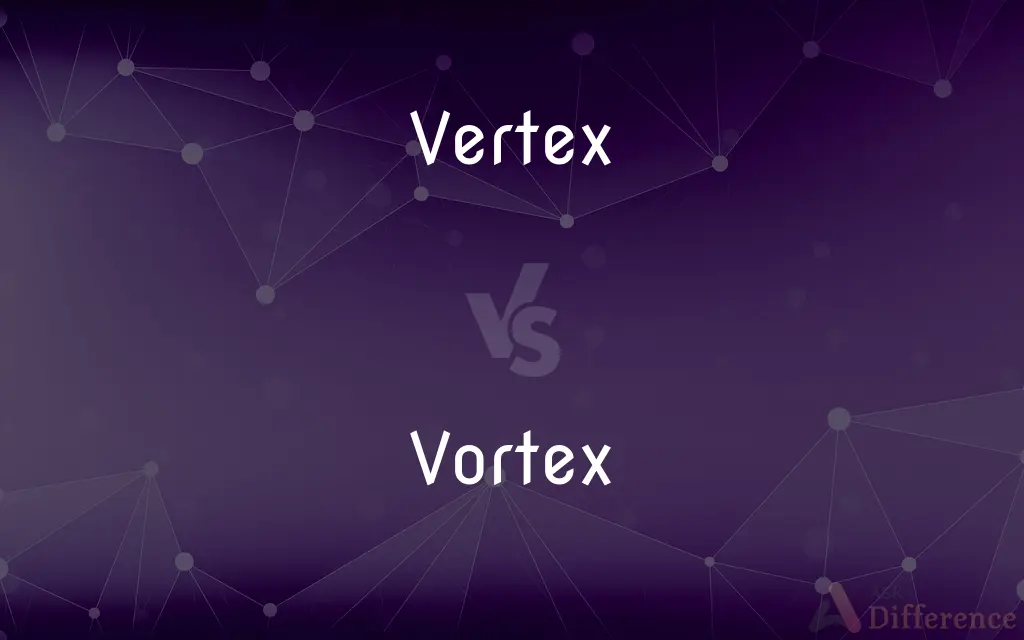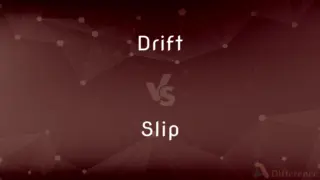Vertex vs. Vortex — What's the Difference?
Edited by Tayyaba Rehman — By Fiza Rafique — Updated on November 2, 2023
Vertex is a singular point where two lines meet, typically in geometry, while vortex refers to a whirling mass, like water or air.

Difference Between Vertex and Vortex
Table of Contents
ADVERTISEMENT
Key Differences
A vertex is the corner or a point where lines, edges, or sides meet, as in geometrical shapes or angles. Vortex, on the other hand, describes a spiral motion of fluid within a limited area, like a tornado or whirlpool.
In mathematics, a vertex is a key concept in shapes and polyhedra, signifying a point in space. Contrarily, a vortex is a dynamic phenomenon often observed in physical environments and fluid dynamics.
The vertex is a static location, defining the end point of an angle or an element in graph theory. A vortex, however, is characterized by its swirling motion, centralizing energy and matter.
Vertices are foundational in computational geometry, aiding in defining shapes and networks. Vortices play crucial roles in meteorology and aerodynamics, influencing weather patterns and aircraft stability.
While the vertex is about convergence and precision in a mathematical context, the vortex represents powerful circular movements in nature and science.
ADVERTISEMENT
Comparison Chart
Definition
A point where two lines meet
A spinning, circular flow
Representation
Geometrical and static
Fluid and dynamic
Role in Math/Science
Defining shapes and angles
Describing motion and forces
Physical Example
Corner of a square
Whirlpool in a body of water
Conceptual Use
Points in graph theory
Models in fluid dynamics
Compare with Definitions
Vertex
A principal point of intersection in a network.
Each node or vertex in the network was connected by three edges.
Vortex
A region within a body of fluid in which the fluid elements have an angular velocity.
Scientists studied the vortex in the wake of the speeding boat.
Vertex
A point where two or more lines or edges meet.
The vertex of an angle was marked with a dot.
Vortex
A mass of whirling fluid or air, especially a whirlpool or whirlwind.
We watched the leaves caught in the vortex of the wind.
Vertex
The highest point; the top or apex.
Vortex
Something regarded as drawing into its powerful current everything that surrounds it.
The celebrity scandal became a vortex of media frenzy.
Vertex
Each angular point of a polygon, polyhedron, or other figure.
Vortex
In fluid dynamics, a vortex (plural vortices/vortexes) is a region in a fluid in which the flow revolves around an axis line, which may be straight or curved. Vortices form in stirred fluids, and may be observed in smoke rings, whirlpools in the wake of a boat, and the winds surrounding a tropical cyclone, tornado or dust devil.
Vertex
The highest point; the apex or summit
The vertex of a mountain.
Vortex
A whirling mass of fluid or air, especially a whirlpool or whirlwind
A swirling vortex of emotions
We were caught in a vortex of water
Vertex
The highest point of the skull.
Vortex
A whirling mass of water or air that sucks everything near it toward its center.
Vertex
The top of the head.
Vortex
A place or situation regarded as drawing into its center all that surrounds it, and hence being inescapable or destructive
A vortex of political infighting.
A vortex of despair.
Vertex
In astrology, the highest point reached in the apparent motion of a celestial body.
Vortex
A whirlwind, whirlpool, or similarly moving matter in the form of a spiral or column.
Vertex
The point at which the sides of an angle intersect.
Vortex
(figuratively) Anything that involves constant violent or chaotic activity around some centre.
Vertex
The point on a triangle or pyramid opposite to and farthest away from its base.
Vortex
(figuratively) Anything that inevitably draws surrounding things into its current.
Vertex
A point on a polyhedron common to three or more sides.
Vortex
(historical) A supposed collection of particles of very subtle matter, endowed with a rapid rotary motion around an axis which was also the axis of a sun or planet; part of a Cartesian theory accounting for the formation of the universe, and the movements of the bodies composing it.
Vertex
A point of maximal curvature on a parabola or hyperbola.
Vortex
(zoology) Any of numerous species of small Turbellaria belonging to Vortex and allied genera.
Vertex
The highest point, top or apex of something.
Vortex
(chemistry) To mix using a vortex mixer
Vertex
(anatomy) The highest surface on the skull; the crown of the head.
Vortex
A mass of fluid, especially of a liquid, having a whirling or circular motion tending to form a cavity or vacuum in the center of the circle, and to draw in towards the center bodies subject to its action; the form assumed by a fluid in such motion; a whirlpool; an eddy.
Vertex
(geometry) An angular point of a polygon, polyhedron or higher order polytope.
Vortex
A supposed collection of particles of very subtile matter, endowed with a rapid rotary motion around an axis which was also the axis of a sun or a planet. Descartes attempted to account for the formation of the universe, and the movements of the bodies composing it, by a theory of vortices.
Vertex
The common point of the two rays that form an angle.
Vortex
Any one of numerous species of small Turbellaria belonging to Vortex and allied genera. See Illustration in Appendix.
Vertex
The point at which an axis meets a curve or surface.
Vortex
The shape of something rotating rapidly
Vertex
(mathematics) A point on the curve with a local minimum or maximum of curvature.
Vortex
A powerful circular current of water (usually the resulting of conflicting tides)
Vertex
(graph theory) One of the elements of a graph joined or not by edges to other vertices.
Vortex
A situation regarded as a whirlpool for violent activity, irresistible force, etc.
The revolution became a vortex of conflicting ideologies.
Vertex
(computer graphics) A point in 3D space, usually given in terms of its Cartesian coordinates.
Vortex
A circular flow with a low-pressure center, pulling objects toward its center.
The vortex of the tornado pulled everything into its center.
Vertex
(optics) The point where the surface of a lens crosses the optical axis.
Vertex
(particle physics) An interaction point.
Vertex
(astrology) The point where the prime vertical meets the ecliptic in the western hemisphere of a natal chart.
Vertex
(typography) A sharp downward point opposite a crotch, as in the letters "V" and "W" but not "Y".
Vertex
A turning point; the principal or highest point; top; summit; crown; apex.
Vertex
The top, or crown, of the head.
Vertex
The zenith, or the point of the heavens directly overhead.
Vertex
The point in any figure opposite to, and farthest from, the base; the terminating point of some particular line or lines in a figure or a curve; the top, or the point opposite the base.
Vertex
The point of intersection of lines or the point opposite the base of a figure
Vertex
The highest point (of something);
At the peak of the pyramid
Vertex
The point opposite to and farthest from the base in a figure.
The cone's vertex is sharp and precise.
Vertex
A point describing the corners of a polyhedral object.
Every vertex of the cube was part of its skeletal structure.
Common Curiosities
What is a vertex in geometry?
A vertex is a point where two or more curves, lines, or edges meet.
What does a vortex do?
A vortex creates a spinning motion of fluid or air around a center of rotation.
How many vertices does a triangle have?
A triangle has three vertices.
How is vortex formed?
A vortex is formed when fluid or air moves in a circular motion around a central axis.
Is vertex only used in math?
While commonly used in math, "vertex" can refer to any angular point.
What are some examples of a vortex?
Examples include tornadoes, whirlpools, and the swirl of a draining bathtub.
Can there be more than one vertex?
Yes, multiple points of intersection are called vertices.
Is the center of a vortex typically calm?
The very center, or eye, of a large vortex, like a hurricane, can be calm.
Can a vortex be dangerous?
Yes, vortices like tornadoes or whirlpools can be very powerful and dangerous.
What are the applications of studying vortices?
Studying vortices can be important in fields like meteorology, aerodynamics, and engineering.
How can you identify a vertex in a graph?
A vertex in a graph is represented as a dot or a node.
What is the plural of vertex?
The plural of vertex is vertices.
Do vortices only occur in liquids?
No, vortices can occur in any fluid, including gases.
What’s the difference between a vertex and a peak?
A vertex is a general term for a corner point, while a peak specifically refers to the topmost vertex.
Do all polygons have a vertex?
Yes, all polygons have vertices where their sides meet.
Share Your Discovery

Previous Comparison
Tutorial vs. Guide
Next Comparison
Drift vs. SlipAuthor Spotlight
Written by
Fiza RafiqueFiza Rafique is a skilled content writer at AskDifference.com, where she meticulously refines and enhances written pieces. Drawing from her vast editorial expertise, Fiza ensures clarity, accuracy, and precision in every article. Passionate about language, she continually seeks to elevate the quality of content for readers worldwide.
Edited by
Tayyaba RehmanTayyaba Rehman is a distinguished writer, currently serving as a primary contributor to askdifference.com. As a researcher in semantics and etymology, Tayyaba's passion for the complexity of languages and their distinctions has found a perfect home on the platform. Tayyaba delves into the intricacies of language, distinguishing between commonly confused words and phrases, thereby providing clarity for readers worldwide.















































